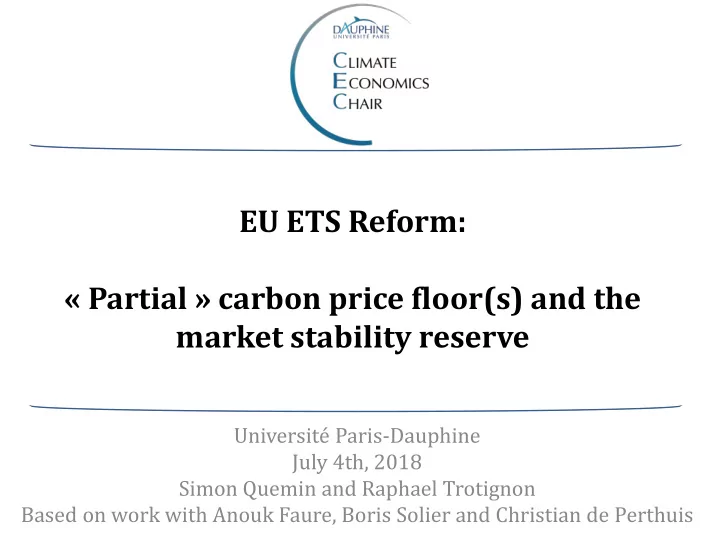

EU ETS Reform: « Partial » carbon price floor(s) and the market stability reserve Université Paris-Dauphine July 4th, 2018 Simon Quemin and Raphael Trotignon Based on work with Anouk Faure, Boris Solier and Christian de Perthuis
Reform and ZEPHYR model in a nutshell Adopted policy package contains 3 provisions to raise ambition • – Increase in LRF & MSR implementation & invalidation of some EUAs in MSR ZEPHYR: Stylized modelling of the EU-ETS with inter-temporal • cost minimization in discrete time for a representative agent Determination of EUA price, emission and banking paths • – Comparison of relative impacts of alternative market design features 2
MSR-induced impact on EUA price The MSR withholds EUAs which reduces supply and increases EUA prices • 3
MSR-induced impact on TNAC The MSR withholds EUAs which reduces the banking volume • 4
Testing the MSR’s stabilizing capacity (1/2) Limited potential to control for sustained differences in EUA demand • 5
Testing the MSR’s stabilizing capacity (2/2) Limited responsiveness in smoothing out short-term demand shocks • 6
Complementing the MSR with a price floor? Although the MSR increases the EUA price and reduces TNAC • – it exhibits a limited demand shock smoothing out potential – and does not solve the governance issue (the amounts of EUA automatically removed from circulation are not directly linked to evaluations of policy interactions nor explicit carbon price targets) Room for considering additional supply-side control tools • – Solution 1: EU-wide price floor (all sectors) e.g. auction reserve price – Solution 2: Coalition-wide price floor(s). Waterbed issue? 7
Analysis of a unilateral carbon price floor Study performed in 2015-2016 to evaluate the effect of a 30€/t • unilateral carbon price floor imposed by France on domestic electricity sector emissions (Canfin-Grandjean-Mestrallet Commission) Using the Zephyr-Electricity model (short term dispatch) • – combination of available generating technologies enabling electricity demand to be met at least cost on an hourly basis over a given year – given hourly available capacities, and hourly fuel and CO 2 prices – Representation of interconnection capacities in the form of « border technologies » to which marginal costs are assigned. – Outputs are electricity mix composition, electricity prices, and CO 2 emissions. Effect on the EU ETS by introducing the lesser demand for EUAs • from electricity plants in the Zephyr model market equilibrium 8
The case of France in 2017: results • A € 30/tCO 2 floor price raises the cost of domestic thermal power generation and leads to, at unchanged demand, a fall in production in favour of imports . – An increase of €2.6 to €3.4 in the price per MWh in the wholesale market as an annual average; – A reduction in domestic emissions of 3.5 to 10 MtCO 2 depending on relative prices of coal and gas, and an increase in import-related emissions of 3.7 to 6.2 MtCO 2 ; – Limited substitution from domestic coal-fired to gas power plants due to cross-border trade. – The impact of the measure on the equilibrium of the EU ETS would be small because of the limited weight of French electricity sector emissions (around - 0.5€/tCO 2 ) 9
The case of an EU wide electricity sector floor A European floor price of €30/tCO 2 improves the competitiveness of • the French low-carbon electricity sector, which reduces imports to the benefit of production . – An €11.6 increase in the price per MWh – Little change in domestic emissions (with increased use of gas power plants and small decline in coal-fired plants) and a decline in import- related emissions ; – The European electricity sector reduces its emissions by 125 MtCO 2 a year . Without adjusting the EU ETS cap, the price of EUA drops to zero for the non-electricity sector “waterbed effect”); – The MSR is not able to prevent the price drop for the other sectors : It only absorbs 12% of additional induced surplus each year (60 Mt removed in 2020 against 500 Mt reduced emissions over 2017-2020) 10
Key messages Emissions reductions induced by a higher carbon price on any sub- • perimeter already in the ETS can make the carbon price drop to zero for the other sectors (waterbed effect) To « preserve » the market from this effect, one should identify, • quantify, and remove from the effective cap the corresponding quantities of EUAs in a frequent, reactive, and transparent way ( major governance issue ) This preliminary analysis suggested that the MSR would not be able • to play this « protection » role . Nevertheless, the MSR can be used as a cancellation mechanism , e.g. • if an auction reserve price is implemented and the allowances removed from the market this way are placed in the MSR 11
Recommend
More recommend